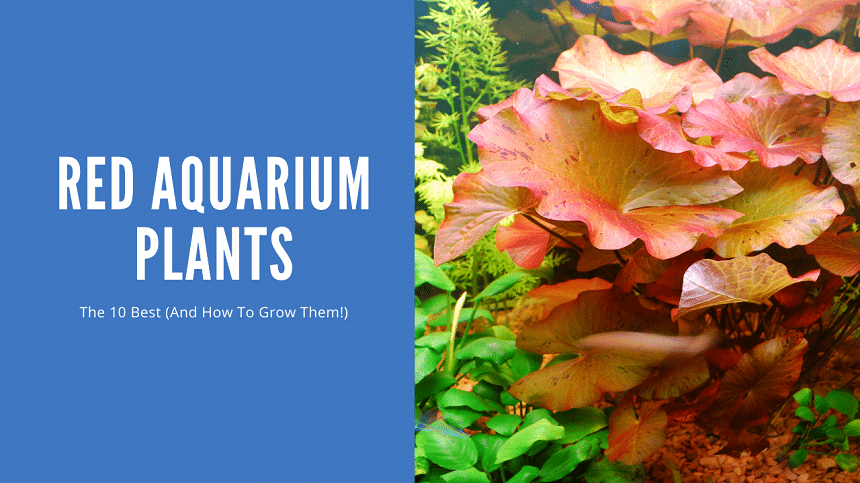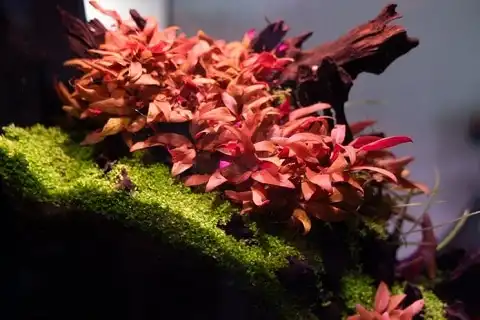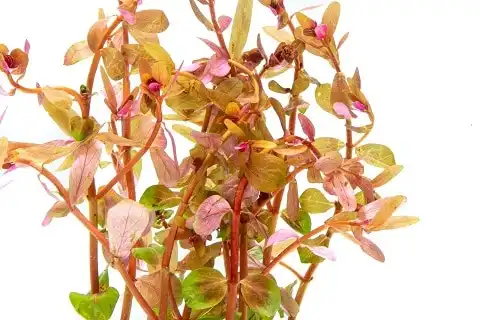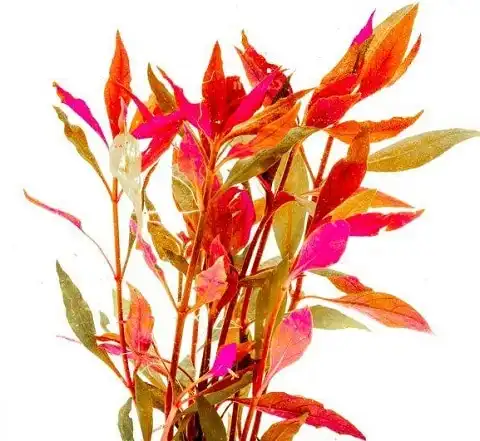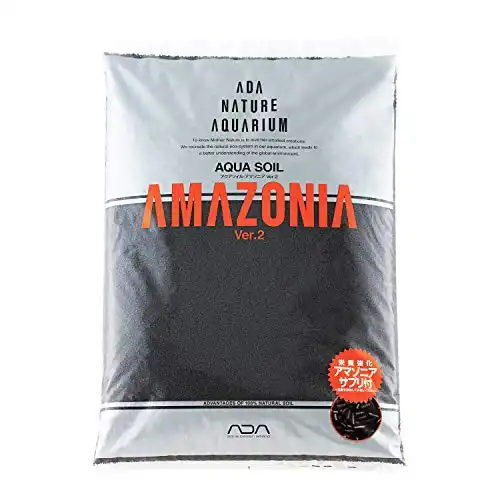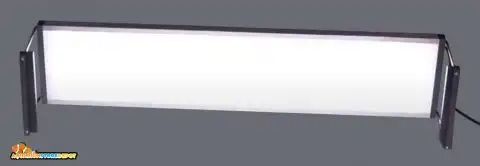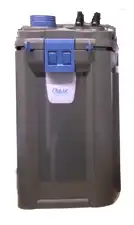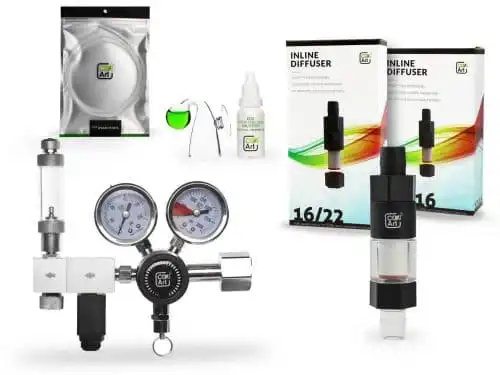Thank you for visiting! By the way… any links on this page that lead to products on Amazon and other stores/partners are affiliate links Aquarium Store Depot earns a commission if you make a purchase.
Have you ever wondered how some aquarists manage to grow red plants in their aquariums?
There’s a lot of mystery surrounding how to achieve bright colors in your red plants, so in this article, I’ll be introducing the 10 best red plants for your aquarium. I’ll also teach you what you need to know to keep them healthy and colorful.
Let’s get started!
Why Grow Red Aquarium Plants?
We got a video for you from our YouTube Channel you can check out all about Red Plants. We go into more detail in the blog post below. Sub to our YouTube channel for more content as we post new videos every week.
If you’ve ever seen an aquascape aquarium with bright and colorful red plants in it, you’ll know what all the fuss is about. Of course, bright green plants are beautiful too, but there’s something special about dramatic rosy foliage that really catches the eye.
Growing healthy red plants can be a little bit challenging for beginners, but with the right equipment and know-how, it is a fascinating side of the planted tank hobby that any aquarist can succeed at!
10 Best Red Aquarium Plants
In a hurry? Check out red plants sold at Buce Plant!
Here we go folks, it’s time to introduce 10 amazing red aquarium plants that you can use in your own aquascape! For each plant, I’ll be providing important information like:
- The plant’s average size
- The recommended placement in the tank
- pH
- Care level
- Light requirements
- CO2 requirement
- Method for propagating new plants
1. Ludwigia natans ‘Super Red’
An amazing red aquarium plant that is easy to grow! A fast growing plant.
- Size: 6-20 inches
- Tank Placement: Mid ground, Background
- Origin: North America
- pH: 6-7
- Care level: Easy
- Lighting: Medium
- CO2 requirement: No, recommended
- Propagation: Rooted cuttings
Ludwigia natans ‘Super Red’ is a great plant to start out with. This fast-growing stem plant for freshwater aquariums is an easy plant to care for but will develop its best color with proper lighting and CO2 injection.
It is a tall, narrow plant when grown singly, but being soft and delicate, it shows great movement when a few stems are planted together in groups.
2. Alternanthera reineckii ‘Mini’
A challenging, but rewarding red aquarium plant. Grows in all placements
- Size: 3-12 inches
- Tank Placement: Foreground, Mid ground, Background
- Origin: South America
- pH: 5-7
- Care level: Moderate
- Lighting: Medium-High
- CO2 requirement: Yes
- Propagation: Rooted cuttings
Alternanthera reineckii is a very popular aquarium plant that is commonly referred to as AR for short. It is a beautiful but fragile plant that is available in many amazing varieties. AR ‘Mini’ is a relatively compact and slow-growing stem plant with amazing color.
Being a slow-growing plant, it can be prone to algae growth on its broad leaf surfaces. Give this plant stable water parameters and regular tank maintenance and it will provide you with incredible foliage and color.
3. Alternanthera reineckii ‘Rosanervig’
A taller red plant that is great for larger aquariums. A moderately difficult plant to keep
- Size: 4-12 inches
- Tank Placement: Mid ground, Background
- Origin: South & Central America
- pH: 6.5-7.5
- Care level: Moderate
- Lighting: Medium-high
- CO2 requirement: Yes
- Propagation: Rooted cuttings
AR ‘Rosanervig’ is a taller variety that makes a great midground plant for larger aquariums. It can even be used as an effective background in small tanks. This gorgeous plant has reddish-green foliage with brilliant pink veins.
4. Rotala rotundifolia ‘Red’
An easy to grow stem plant with red colors. Easy to trim and propagate
- Size: 8+ inches
- Tank Placement: Background
- Origin: Southeast Asia
- pH: 6.5-7.5
- Care level: Easy
- Lighting: High
- CO2 requirement: Yes
- Propagation: Rooted cuttings
Rotala rotundifolia ‘Red’is an easy-to-grow stem plant that can add amazing color to your aquarium. This fast-growing aquatic plant produces its best colors when nitrogen is limited in the tank. It is easy to trim and propagate, which makes it an excellent choice for aquascaping.
5. Rotala macrandra ‘Mini’
A fast growing red plan that requires intense lighting and correct nutrient balance
- Size: 8-11 inches
- Tank Placement: Background, Mid ground
- Origin: India
- pH: 5-7.5
- Care level: Advanced
- Lighting: High
- CO2 requirement: Yes
- Propagation: Root cut side shoots in substrate
Rotala macranda ‘Mini’ is a spectacular but challenging aquatic plant for more experienced aquarists. These stem plants grow quickly with the right care, but need intense lighting and the correct nutrient balance to thrive.
This plant also needs limited nitrates to develop its red coloration, just like the previous species. Furthermore, it also needs acidic, soft water and increased carbon dioxide (CO2) levels. Are you ready for the challenge of growing this striking plant?
6. Nymphaea zenkeri – Tiger Lotus
- Size: 4-30 inches
- Tank Placement: Floating plant, midground
- Origin: Africa
- pH: 6-7.5
- Care level: Easy
- Lighting: Moderate
- CO2 requirement: Recommended
- Propagation: Root side shoots
The red tiger lotus (video source from Tropica) is a bold aquatic aquarium plant that can be used as a centerpiece plant for the mid-ground. This hardy plant species is almost a combination of a stem plant and a floating plant in that it grow its root system in the substrate while producing large, flat, floating leaves on the water surface.
The Red tiger lotus plant is easy to grow but will show its best red color if provided with high-intensity lighting system, additional carbon dioxide, and enough nutrients.
7. Ludwigia peruensis
A two tone foliage plant. Needs intense lighting and balanced nutrient levels
- Size: 18 inches
- Tank Placement: Midground, Background
- Origin: North America
- pH: 6.5-7.5
- Care level: Moderate
- Lighting: High
- CO2 requirement: Yes
- Propagation: Rooted cuttings
This Ludwigia species is very popular for its two-tone foliage. Each amazing leaf is green above and red below. It makes a fine background plant for small aquariums or can be used in the midground of larger tanks.
8. Alternanthera Lilacina
Provides deep reds and purples in an aquarium. A great choice for dutch style aquascapes
- Size: 4-12+ inches
- Tank Placement: Midground, Background
- Origin: South America
- pH: 6.5-7.5
- Care level: Easy-Moderate
- Lighting: Medium-high
- CO2 requirement: Yes
- Propagation: Rooted cuttings
This colorful AR variety is popular for its deep red stems and pink to red young growth. The undersides of the leaves are often a striking purple color.
It is a pretty undemanding plant that has a moderate growth rate under bright lighting. This is an excellent plant for dutch style planted aquarium, providing intense color.
9. Alternanthera reineckii ‘Rosaefolia Mini’
The smallest variant of the AR Rosaefolias. Requires medium to intense lighting and CO2 injection
- Size: 8 inches
- Tank Placement: Midground
- Origin: South America
- pH: 5-7
- Care level: Moderate
- Lighting: Medium-High
- CO2 requirement: Yes
- Propagation: Rooted cuttings
AR ‘Roseafolia Mini’ is a small plant that has a big presence in any planted fish tank. Its stems and foliage can be seen in a variety of reddish hues from pink, through red, to purple with intense lighting.
This versatile plant is a great size for the midground of most aquaria, and can even be trimmed down to create a lush red carpet effect in a large aquarium.
10. Phyllanthus fluitans – Red Root Floater
A floating red plant with red coloration. Great for low tech tanks and paludariums
- Size: 1 inch
- Tank Placement: Floating plant
- Origin: South America
- pH: 6.5-7.5
- Care level: Easy
- Lighting: Medium-High
- CO2 requirement: No
- Propagation: Side-shoot division
Unlike the other plants in this list, the red root floater is not rooted in the substrate. In fact, these stunning plants float at the water’s surface just like water lilies. Their tiny roots trail down into the water creating an enchanting underwater scene.
As the name suggests, these popular floating aquarium plants are best known for their bright red roots. The leaves themselves will also be a beautiful red shade if grown under bright light.
Tank setup
Now that you’ve learned about ten great plants that you can grow in your fish tank, let’s take a closer look at what you’ll need to grow healthy red aquarium plants.
Substrate
You should select a nutrient rich substrate for most popular aquatic plants that are rooted. The exceptions, of course, are floating plants like the red root floater and some epiphytes.
Aquasoils are a soil-based nutrient rich substrate designed specifically for planted tanks. There are many great options on the market, including popular varieties like:
- ADA Amazonia
- Fluval Stratum
- Tropica Aquarium Soil
The Best Planted Tank Substrate
The world's standard in active substrates for planted tanks. Created by brand that founded modern aquascaping
Lighting
Providing strong enough light intensity is the number one requirement for vibrant red aquarium plants. Many plants will grow quite happily in low light but remain green or just lack that wow factor that we want from the red plant species.
It is important to remember that light intensity diminishes quickly with depth. This means that low-growing plants will be getting a lot less light than taller plants. For this reason, deeper aquariums will also need stronger lighting, even if they hold the same volume of water.
A PAR level of about 100 umols measured at the bottom of the tank is a good value to aim for. This will bring out great color in most of the red aquatic plants
The Light Spectrum
When considering the needs of an aquatic plant, not just any bright light will do.
Lighting that is turned up in the blue and red spectrum is ideal, but only so much as to maintain a natural and visually pleasing look. The red spectrum not only makes red aquarium plants appear redder but also helps them develop their color.
The Best LED for Planted Tanks
Twinstar nails the spectrum, has the proper spread and comes with a sleek design. Perfect for aquascapers
Filtration
When selecting a filtration system, opt for a model that provides a good flow and a high water turnover. A turnover rate of 5 times the volume of your aquarium per hour is a good place to start.
You can use an internal power filter or a hang-on back design to filter your aquarium, but external filters are best for creating beautiful display tanks. This is because canister filters are housed outside of the aquarium, so you won’t have to hide any hardware. OASE makes the best canister filters on the market. They are the top choice for planted aquarium owners today.
The Pro's Choice
The top choice among professional aquascapers. German engineering and equipped with an intregrated heater.
How To Grow These Tank Plants
Maintaining healthy aquatic plants of any color requires an understanding of the basics of plant care. Put simply, plants need:
- Light
- Water
- Carbon dioxide
- Nutrients
That’s not all that aquatic plants need, however. You should also provide the following:
- A suitable rich substrate
- The correct temperature range
- Suitable parameters like water hardness and pH
- Healthy water flow
- Good plant spacing and trimming
With this in mind, let’s take a look at the specifics you need to know for growing red plants in particular.
Growing With CO2 Supplementation
Carbon dioxide is absolutely necessary for healthy plant growth, and red plants species are no exception. Although this gas is present in all aquariums, you will need to provide an increased concentration to really see your plants flourish.
The fact is, your aquarium plants simply can’t make use of bright light without elevated CO2 levels. In fact, intense light without CO2 will probably just grow you a whole lot of algae!
CO2 Injection Systems
CO2 supplementation might be the secret ingredient for amazing plant growth, but this gas has a dark side too. It is lethal in high concentrations (above 30ppm), which is a huge problem if you keep any fish or live animals in your aquarium.
Fortunately, there are some amazing products and systems available to the modern hobbyist that make running CO2 safely pretty simple. An example of a great CO2 system includes the following components:
- Pressurized CO2 canister
- Co2 regulator
- Diffuser
- Bubble counter
- Drop checker and solution
- Timer
Use Offer Code ASD10%Off
The highest end offering by CO2Art. This package includes everything you need to perform consistent and the highest quality CO2 injection in the industry!
Using this kind of setup, you can set your injection system to provide dissolved carbon dioxide levels between 15 and 30ppm exactly when the plants need it.
Since plants need light to use CO2, you’ll want to set your timer to fire up an hour or two before the lights go on, and then switch off at the same time as the lights go out.
Maintaining Good Water Quality
Creating an amazing underwater garden requires regular maintenance. Here’s what you’ll need to do to keep your red plants healthy and looking great:
- Vacuum your gravel and carpet plants with a gravel vacuum to remove physical waste and uneaten fish food
- Keep your glass clean with an algae scraper
- Trim plants that are growing too large and shading out other plants. Use a sharp pair of aquascaping scissors for this task
- Remove all trimmings and dead plant material from the tank
- Rinse out your filter media or replace cartridges when necessary
- Perform a weekly water changes. Start with about 25%, but measure your nitrate levels to fine-tune your routine
Testing
A good test kit is an essential tool for maintaining a healthy aquarium and one of the best purchases you will ever make. A test kit allows you to determine whether your tank is cycled, measure the parameters of your tap water, and monitor the nitrate levels in your aquarium.
Supplements And Feeding
Your aquarium plants require regular feeding of aquarium fertilizers to keep up with the demands of growth under high light and increased CO2 levels.
A product like APT Zero from the 2Hr Aquarist is an ideal all-in-one solution for amazing growth for a planted fish tank. This formula lacks nitrate, which is great for keeping nitrogen levels down and boosting red colors while minimizing algae growth.
Use Discount Code ASDComplete
APT zero offers a the great supplementation of APT Complete, but want to control nitrate loads with dosing. For heavily planted dutch style tanks, go with APT Estimative Index
Nitrogen Limitation
Many red plants look their best and develop their most intense coloration in a low nitrogen environment. That’s why reducing the nitrates in the water through regular water changes can be so important.
This technique does not work for all red plants, however, but species like Rotala rotundifolia certainly do respond best to low nitrate levels. It is not realistic to maintain zero nitrates in the long term, especially if you keep fish. Of course, plants need some nitrogen to grow, so a prolonged absence of this important element will stunt and even kill plants.
It is feasible to aim for nitrate levels below 5ppm, however, especially as a temporary method to bring out the best colors for a photo shoot for example.
Pests and other problems
The most common issues with red plants are poor color, and we know this is often a result of incorrect light, CO2 supplementation, and nutrient levels. Let’s take a look at some of the problems you may encounter.
Unwelcome Guests
Pests like snails and planaria are often introduced to aquariums as stow-aways on new aquarium plants. These animals don’t typically affect the plants themselves, but can be a major headache for other reasons. The best way to avoid introducing these pests is to grow tissue culture plants that are produced in sterile conditions.
Hungry Herbivores
Some common aquarium fish will feast on your red plants too. The following species are the usual suspects:
- Silver dollars
- Goldfish
- Common plecos
- Various cichlids
Instability And Melting
Aquarium plants can die back pretty alarmingly when they are moved into different environments. This phenomenon is known as melting, and it is very common.
Often, the plants you buy were grown emersed (out of water), and being submerged underwater is a huge shock. The plant responds by getting rid of its old air-loving leaves and replacing them with new ones that are ready for life underwater. Most plants will bounce back pretty quickly, and all you need to do is remove all the dead, brown or dying leaves before it rots in your fish tank.
Another potential cause for melt is unstable parameters and poor water quality. Keeping up with regular aquarium maintenance is the best way to avoid this problem.
Algae
Algae often thrive under the intense lighting needed to create a vibrant red aquarium plant. Balancing your light, nutrients, and carbon dioxide (CO2) is the best way to manage this problem, but there are some other options too.
One of the best ways to combat algae is to have plenty of healthy, fast-growing plants to outcompete this common aquarium villain. If your planted aquarium is still young and growing, there are some other options too.
Algae-eating aquarium animals can do an awesome job of keeping your tank clean, and what’s more, they are amazing creatures in their own right! Fish like Otocinclus catfish, and inverts like Amano shrimp and nerite snails are the first species that come to mind, but check out my article on aquarium algae eaters for even more great options.
If you prefer to keep plants only, there are some great products available for managing the algae in your tank. The APT Fix algae treatment is ideal for spot treating any algae in the tank before it can grow into a headache.
Use Coupon Code ASDComplete
APT Fix is a spot dosage treatment that works great for planted tanks. Effective and easy to use. Won't hurt plants or livestock
Where To Buy
Your local fish store is always worth checking out for aquarium plants. Always make certain, however, that the plants are correctly labeled.
For the most part, the best place to shop for a wide variety of red plants is online. Buceplant.com is one of the most trusted online aquarium plant retailers, and they stock an amazing range of the best red aquarium plants for your fish tank.
FAQs
Do you need CO2 for these types of Tank plants?
Not all red aquarium plants need injected CO2 to grow in the home aquarium. However, all of them will benefit from increased carbon dioxide, with faster and more robust growth.
Do they need more light?
Yes, most red aquarium plants need high lighting to look their best. There are always exceptions, but most species will require high, or at least moderate light to look their best.
How do you keep these a vibrant color?
To keep red aquarium plants red you will need to provide them sufficient light, nutrients, and carbon dioxide. Some plants also respond to very low nitrate levels by turning red.
What does red-light do for Tank greenery?
Red light can make red plants look even redder. The red part of the light spectrum helps plants grow tall and even is also known to stimulate flowering. On the other hand, too much red light can look unnatural, and even cause increased algae growth.
Do they need iron?
Red aquatic plants certainly need iron to grow healthy. Iron is one of the trace elements that all plants need, however, and it does not increase the red color in plants.
Final Thoughts
Red aquatic plants are often that X-factor that makes a good aquascape greatSure, they are an eye catching plant and can be a little needier than a green plant, but the results are worth it!
Do you love red plants as much as I do? If so, share your favorite red plant below. Happy aquascaping!
- About the Author
- Latest Posts
I’m thrilled that you found Aquarium Store Depot! Here you’ll find information on fish, aquariums, and all things aquatics related. I’m a hobbyist (being doing this since I was 11) and here to help other hobbyists thrive with their aquariums! I adhere to a high quality Editorial Process and Review products with real life field usage and practical analysis.

